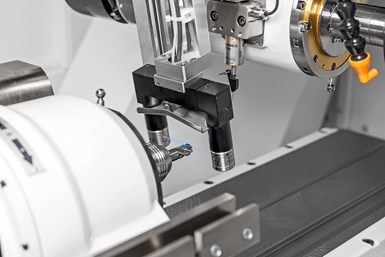Non-Contact Blue-Laser Measurement System
Laser Contour Check provides high-precision measurement of various tool parameters on cylindrical tools with diameters from 1 to 52 mm.
Share





Walter USA, a brand of United Grinding, introduces Laser Contour Check, a new and innovative non-contact option to tactile measurement in tool grinding and eroding machines.
The new blue laser, paired with an intelligent measuring system, provides high-precision measurement of various tool parameters on cylindrical tools with diameters from 1 to 52 mm. Since it does not contact the surface, the Laser Contour Check avoids possible damage to cutting edges or measuring errors that can occur due to wear on the probe tip during tactile measurements.
Measurements are made directly in the analog laser beam on the entire tool contour, not just at specific points as with the tactile or digital measuring method. Deviations can thus be compensated for directly in the process, Walter says. The system provides a short measuring time, including cleaning of approximately 16 seconds (depending on the tool type) for diameter measurement.
Optimized program sequences for cleaning and compensation can be programmed and adapted by the operator. The measuring system is integrated directly into the working area of the machine and moves into position when required. The blue laser beam reportedly offers improved accuracy compared to the conventional red laser, as blue lasers have a shorter wavelength, thus reducing diffraction effects and optimizing the laser beam geometry.
Related Content
-
How to Choose the Correct Measuring Tool for Any Application
There are many options to choose from when deciding on a dimensional measurement tool. Consider these application-based factors when selecting a measurement solution.
-
Ballbar Testing Benefits Low-Volume Manufacturing
Thanks to ballbar testing with a Renishaw QC20-W, the Autodesk Technology Centers now have more confidence in their machine tools.
-
4 Ways to Establish Machine Accuracy
Understanding all the things that contribute to a machine’s full potential accuracy will inform what to prioritize when fine-tuning the machine.






















